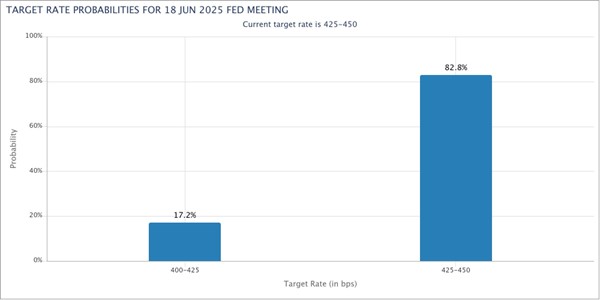
World Market Insights – Week 19, 2025: Markets Pause, Macro Questions Linger
Welcome to your Week 19 market digest. This one’s a little longer, which, as the markets seem a little flat and unmoved, might seem counterintuitive. However, I want to expand a little on why I keep talking about interest rates and Jerome Powell impacting risk assets and macroeconomic growth, so you may want to add a healthy breakfast to your coffee….. think of it as fuel for both body and mind as we navigate another week of global economic intrigue.
Last Week Recap: Flat Markets, Sticky Inflation, and the Rate Cut Waiting Game
World Market Insights – Week 18, 2025: GDP Stumbles, PCE Steals the Spotlight
If you’ve been following along, last week’s headlines were dominated by a stubbornly high PCE Price Index (the Fed’s preferred inflation gauge) and a US GDP print that looked weak on the surface but masked strong private sector demand. The Fed, true to form, kept everyone guessing, sticking to its “data-dependent” mantra as inflation remained above target and the labour market stayed resilient. I know I said to listen to what Jerome Powell had to say and not do, well, he said and did nothing.
And from that markets expect little movement in the FED for next month as well now.

This Week: Markets Pause, Macro Questions Linger
Markets: Uninspired but Not Alarmed

Figure 1. Source: Yahoo finance.
Despite a busy news cycle, risk assets have been largely rangebound. US equities drifted sideways, European markets showed little conviction after strong growth earlier in the year, and even gold took a breather after its recent run-up. Bond yields remained high, reflecting ongoing uncertainty about when-or if-the Fed will start cutting rates.
The Macro Backdrop: So why do I keep talking so much about the FED interest rates?
I do seem to be a bit of a stuck record on interest rates and global liquidity when it comes to risk assets (public and private equity alike). So, bear with me-let’s zoom out and take a macro-economic journey (Raoul Pal-style), something I reflected on in my year-end message and will expand below.
The GDP Equation: Demographics, Productivity, and Debt
Raoul Pal’s framework for understanding macroeconomic growth is elegantly simple:
Long-term GDP growth = Population growth + Productivity growth + Debt growth.
So how does this interpret into what we see today:
Demographics: Aging populations in developed economies mean fewer workers entering the labour force. The old-age dependency ratio is rising, shrinking the workforce and organic growth potential.
Productivity: Gains have stagnated globally. An aging workforce (less productive than younger cohorts) and slower technological adoption post-2008 have compounded this.
Debt: With demographics and productivity faltering, debt became the default growth lever. Since 2008, global debt has exploded—but now, debt is no longer fuelling growth; it’s servicing past obligations.
“GDP is the income used to pay off debt + interest. If GDP doesn’t grow, debt becomes unsustainable.” – Raoul Pal
The Debt Trap: From Growth Engine to Drag

For decades, low interest rates made debt manageable. But today, with rates at multi-decade highs (Fed Funds Rate: 4.25–4.5%), debt servicing costs are eating into growth:
Government debt: The U.S. federal debt is over 100%+ of GDP peaking at 130%. At current rates, interest payments alone could consume 8% of tax revenues by 2025.
Corporate debt: Refinancing at higher rates squeezes margins, forcing companies to cut investment or jobs.
Household debt: Mortgage rates near 7% and credit card APRs above 20% constrain consumer spending.
This is why I focus on central bank policy as the “master switch” for the global economy. With debt servicing consuming so much of GDP, even small movements in interest rates can create (or withdraw) significant liquidity for growth.
The Fed’s Tightrope: Inflation vs. Growth
Today, the Fed (and with that I refer to all western central banks) faces an impossible choice:
Keep rates high to fight inflation (PCE at 3.6%!), but risk tipping the economy into recession as debt servicing costs continue to bite.
Cut rates to ease liquidity, but risk reigniting inflation and currency devaluation.
The result? A “higher for longer” regime that stifles growth while failing to tame inflation-a stagflation-lite environment. Also, something to avoid, so it is a tightrope that someone like Powell carefully needs to walk along.
Conclusion: Central banks are still in the driver’s seat of economic growth; more so than tariff news and posturing.
Fed: Powell and team remain cautious, with recent FOMC minutes showing concern about sticky inflation and the risk of cutting rates too soon. The market is now pricing in fewer rate cuts for 2025 than it was just a few months ago.
ECB: The European Central Bank faces its own balancing act, with sluggish growth and the risk that higher rates could further constrain bank lending and economic activity.
China: Liquidity pressures are evident, with net financial outflows weighing on the renminbi and prompting targeted policy support for key sectors.
Even as headlines often focus on trade disputes or political maneuvering, it’s the underlying cost of capital, set by central banks, that truly shapes the economic landscape. Ultimately, it is monetary policy that determines whether economies have the breathing room to grow or are forced to tighten their belts.
For investors, this means that keeping an ear to the ground on central bank policy is more important than ever, as it will set the tone for risk assets and economic momentum in the months ahead.
Impact on Private Equity and Risk Assets
Why Does This Matter for Private Equity and Risk Assets?
Liquidity Drives Valuations: When central banks cut rates or inject liquidity, it tends to boost valuations for risk assets; equities, private equity, real estate, and more. When liquidity tightens, multiples compress and fundraising gets harder.
Debt Servicing and Growth: As debt servicing costs rise, less capital is available for growth investments, M&A, and expansion (especially for smaller businesses) more reliant on debt capital.
Macro Uncertainty: Policy uncertainty (from elections, tariffs, or central bank moves) keeps volatility elevated and makes it harder to plan long-term investments.
Implications for Private Equity and Risk Assets
Watch liquidity, not just rates: The Fed’s balance sheet (QT vs. QE) matters more than headlines about rate cuts. Indeed, as things heat up this will also be an area I will be talking about more over the weeks.
Debt-heavy sectors at risk: Avoid overleveraged companies; favor sectors with strong cash flows (tech, healthcare).
Prepare for volatility: Macro uncertainty (elections, tariffs, policy shifts) will keep markets on edge.
Look for fundamentals on productivity growth: like AI integration, FinTech developments, and the unlocking of assets like real estate and gold into liquid markets.
As we look ahead, it’s important to remember that volatility and uncertainty are not just risks, but also sources of opportunity for those who are prepared. Staying nimble and focusing on sectors with good future fundamentals while watching the signals from central banks; will be key for navigating the current environment.
Ed’s Macro Takeaway
We’re living through a period where global growth is modest (the US is forecast at just 2% for 2025, the Eurozone even less), and the “higher for longer” interest rate regime is making it harder for debt to do the heavy lifting for GDP. That’s why I keep watching Powell, the Fed, and global liquidity so closely: until we see a clear shift in policy or a decisive move in inflation, risk assets and macro growth will reveal their true potential for growth, and perhaps like a coiled spring once the debt tension releases, we could see a tremendous uncoiling of tension.
No additional reading this week as I think you have read well enough, but if you are interested then reach out to me and I will happily send you, my notes.
Week 19, 2025: Sometimes, the most important moves are the ones that haven’t happened yet.
Questions, comments, or a good joke to share? Just reply to this email or contact your Beaufort investment consultant directly.
As always, these are my own views and not those of Beaufort Private Equity. Please do your own research before making any investment decisions.
